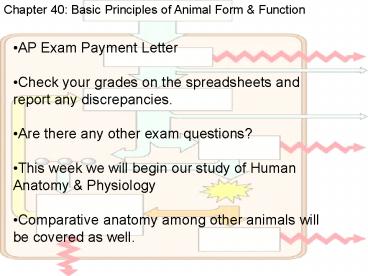Chapter 40: Basic Principles of Animal Form - PowerPoint PPT Presentation
Title:
Chapter 40: Basic Principles of Animal Form
Description:
Chapter 40: Basic Principles of Animal Form & Function AP Exam Payment Letter Check your grades on the spreadsheets and report any discrepancies. – PowerPoint PPT presentation
Number of Views:222
Avg rating:3.0/5.0
Title: Chapter 40: Basic Principles of Animal Form
1
Chapter 40 Basic Principles of Animal Form
Function
- AP Exam Payment Letter
- Check your grades on the spreadsheets and report
any discrepancies. - Are there any other exam questions?
- This week we will begin our study of Human
Anatomy Physiology - Comparative anatomy among other animals will be
covered as well.
2
Chapter 40 Basic Principles of Animal Form
Function
Type of Evolution? Convergent evolution in fast
swimmers Homology or analogy? Analogy traits
that each lineage evolved independently
3
Chapter 40 Basic Principles of Animal Form
Function
- How has exchange with the environment evolved?
- Simple diffusion from direct contact w/
environment - To internal exchange thru moist medium
4
Figure 40.3 Contact with the environment
5
Figure 40.4 Internal exchange surfaces of complex
animals
6
Chapter 40 Basic Principles of Animal Form
Function
- Reviewwhat is the hierarchy of biological
organization? - Atoms?
- molecules?
- organelles?
- cells?
- tissues?
- organs?
- organ systems
7
What is a tissue what are the 4 types?
- Group of cells in a matrix w/a common structure
function - Epithelial
- Connective
- Muscular
- Nervous
8
- Epithelial Tissue
- Tightly packed sheets, cover the body, line
organs cavities w/in the body - Involved w/ secretion absorption
9
- Connective Tissue
- Binds supports other tissues
- 3 types
- Collagenous
- non-elastic skin wont rip
- Elastic
- elastin skin reshapes
- Reticular
- Thin branched
- Made of collagen
- Joins connective tissue to neighboring tissue
10
- Muscle tissue (ch 49)
- Long cells made of contractile proteins
- Actin myosin
11
- Muscle tissue (ch 49)
- 3 kinds
- 1. Skeletal aka striated (w/ lines)
- 2. Cardiac heart branched cells
- 3. Smooth
- no striations
- In walls of digestive tract,
- bladder, arteries
12
- Nervous tissue (ch 48)
- Sense stimuli transmits signals
- neuron
13
Chapter 40 Basic Principles of Animal Form
Function
- What is metabolism?
- All of the chemical rxns within an organism
- Catabolism
- breaks bonds releases energy
- exergonic
- Anabolism
- forms bonds requires energy endergonic
14
Figure 40.7 Bioenergetics of an animal an
overview
15
Chapter 40 Basic Principles of Animal Form
Function
- What is homeostasis?
- Steady state, maintaining a constant condition of
properties - regulating internal environment
- How is it achieved?
- Negative feedback
- the response is in the opposite direction of the
stimulus - - Positive feedback
- -response stimulus are in the
- same direction
16
Figure 40.11 A nonliving example of negative
feedback control of room temperature
How is set point maintained?
17
Chapter 40 Basic Principles of Animal Form
Function
- What are the 2 types of thermoregulation?
- Ectothermic heat metabolism based on
environment - Endothermic heat metabolism regulated
internally
18
Figure 40.12 The relationship between body
temperature and environmental temperature in an
aquatic endotherm and ectotherm
19
- How do organisms exchange heat with their
environment? - Radiation
- Emission of electromagnetic waves
- Evaporation
- Removal of heat from a surface of a liquid as gas
molecules are released - Convection
- Transfer of heat by the movement of air past a
surface - Conduction
- Transfer of heat from objects in direct contact
20
Figure 40.13 Heat exchange between an organism
and its environment
Radiation is the emission of electromagnetic
waves by all objects warmer than absolute zero.
Radiation can transfer heat between objects that
are not in direct contact, as when a lizard
absorbs heat radiating from the sun.
Evaporation is the removal of heat from the
surface of a liquid that is losing some of its
molecules as gas. Evaporation of water from a
lizards moist surfaces that are exposed to the
environment has a strong cooling effect.
Convection is the transfer of heat by the
movement of air or liquid past a surface, as
when a breeze contributes to heat loss from a
lizards dry skin, or blood moves heat from the
body core to the extremities.
Conduction is the direct transfer of thermal
motion (heat) between molecules of objects in
direct contact with each other, as when a lizard
sits on a hot rock.
21
Chapter 40 Basic Principles of Animal Form
Function
- How can organisms exchange heat within their
bodies? - Countercurrent heat exchange
- Arteries carrying warm blood/fluid down
extremities - Passing veins carrying cool blood/fluid
- Heat transfers from artery to vein
22
Figure 40.15 Countercurrent heat exchangers
23
How do we achieve homeostasis for body
temperature? 36-38oC internal temp. Above set
pt. hypothalamus ? sweat glands skin blood
vessels dilate result? Back to set pt.
Fig. 40.21 Human Thermoregulation
24
How do we achieve homeostasis for body
temperature? 36-38oC internal temp. Below set
pt. hypothalamus ? constrict blood vessels in
skin contract skeletal muscles
(shivering) Result?
Fig. 40.21 Human Thermoregulation
25
Chapter 40 Basic Principles of Animal Form
Function
- How do animals thermoregulate in temperature
extremes? - Torpor physiological state in which activity is
low - metabolism is decreased
- Hibernation winter bears, Beldings ground
squirrels - Estivation summer many reptiles, bees
26
Figure 40.22 Body temperature and metabolism
during hibernation in Beldings ground squirrels
Additional metabolism that would be necessary to
stay active in winter
200
Actual metabolism
100
Metabolic rate (kcal per day)
0
Arousals
35
Body temperature
30
25
20
Temperature (C)
15
10
5
Outside temperature
0
Burrow temperature
-5
-10
-15
June
August
October
December
February
April































